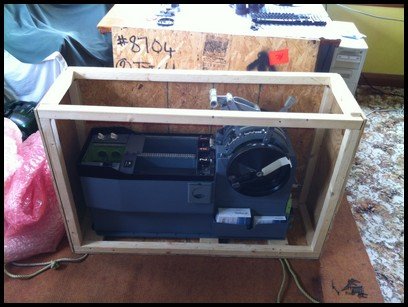Video - Operational Trim Wheels & Indicators
/Now that the throttle quadrant is operational, USB hubs working and the Phidgets correctly configured, I thought I’d post a short video clip showing the trim wheel operation. The wheel spin is controlled by inputs either from the auto pilot or from electric trim switches located on the yoke. When the wheels spin, there is corresponding movement of the trim wheel indicator tabs; the indicators, which are coloured white show the pitch of the aircraft.
Currently, the trim wheels spin at only one speed (mono-speed adjustable in the Phidget settings). Later on, when I have time I'll be altering the speed to variable-speed This will allow the wheels to spin at differing speeds dependent upon whether the aircraft is being controlled manually or by the autopilot. This configuration requires some extra time with Phidgets and is not essential at the present time.
The trim wheels are connected to a 12 volt DC servo motor. The motor is mounted inside the throttle quadrant near the actual wheels. To control the power to the servo motor I have used a Phidget advanced servo motor controller. Double click video to view full screen.
Safety First
The trim wheels have a white line painted on them for a very good reason (not invasion markings for D-Day 1944). The spinning wheels are dangerous – keep your fingers well away when they are operational! The white line, when spinning acts as a visual warning to pilots that the wheels are spinning. It also provides a means with which to calibrate the rotation speed of the trim wheels. Each wheel also has a pull out handle that can be used to control trim manually. Like your fingers, if your knee is in front of the handle when the wheels spin expect a solid whack on your knee cap. I’ve been told by a real world B737 Captain, that there have been several occasions when pilots have suffered injuries to knee caps from being whacked by spinning wheels, after inadvertently leaving the handle extended. As for me, well when they first "spun" into action the cup of coffee that was resting slightly against the wheel spun across the floor :)
Stab Trim Switch Cut Out
As you can image, spinning trim wheels can be slightly annoying and very noisy – especially if you’re flying at night and others in the house are attempting to sleep. Therefore, to stop the trim wheels spinning, I have programmed the trim stabilizer (stab trim) switches on the throttle quadrant to cut the power to the servo motor. Push the stab trim switches to normal and the wheel spin; push the switch down and spinning stops. Although the spinning stops, the trim indicator tabs still move.
In a real B737 this switch is used to stop run away trim wheels, so there is a certain amount of authenticity connecting this functionality to this switch.
Trim Tabs – Why Are They Important?
The use of trim tabs (elevator & pitch) significantly reduces pilot’s workload during continuous flight maneuvers (sustained climb to altitude after takeoff or descent prior to landing), allowing them to focus their attention on other tasks such as traffic avoidance or communication with ATC.
Trim affects the small trimming part of the elevator on jet airliners. Trim (controlled by the trim switch on the yoke) is used all the time after the flying pilot has disabled the autopilot, especially after each time the flaps are lowered or at every change in the airspeed, at the descent, approach and final. Trim is most used for controlling the attitude at cruising by the autopilot.
Correct trim frees the pilot from exerting constant pressure on the pitch controls for a given airspeed / weight distribution. Typically, when the trim control is rotated forward, the nose is held down; conversely, if the trim wheel is moved back, the tail becomes heavy and the nose is held high.
Trim Tabs - Technical Hype (the basics)
When a trim tab is employed, it is moved into the slipstream opposite to the control surface's desired deflection. For example, in order to trim an elevator to hold the nose down, the elevator's trim tab will actually rise up into the slipstream. The increased pressure on top of the trim tab surface caused by raising it will then deflect the entire elevator slab down slightly, causing the tail to rise and the aircraft's nose to move down. In the case of an aircraft where the deployment of flaps would significantly alter the longitudinal trim, a supplementary trim tab is arranged to simultaneously deploy with the flaps so that pitch attitude is not markedly changed.


















































